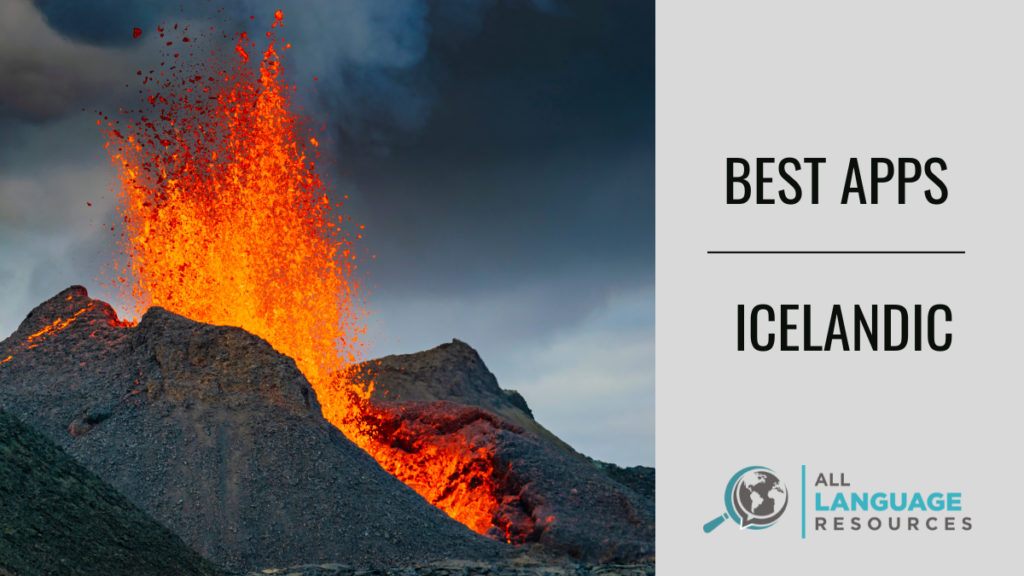The Icelandic language is considered a pure language. Meaning that it doesn’t include loanwords in the language.
Whether you want to travel to Iceland, connect with Icelandic friends and family, or you’re just curious about Icelandic history and culture. Whatever your reasons for learning, you need to know what resources to look out for to get started.
It may not be spoken by a large number of people—about 330000 people—but learning Icelandic could be equally fun and rewarding. You may even be able to read historical text!
Looking for the best apps to learn Icelandic? We’ve tested various resources to come up with a list of the best apps, courses, podcasts, YouTube, and more.
Stick around as we share some key resources that’ll help you prepare accordingly.
Table of Contents
Resources for Learning Icelandic Online
Where to learn Icelandic Online? Language classes and exchanges, apps, audio courses, podcasts, movies, and books: there are plenty of ways to study Icelandic.
Online Icelandic Classes and Language Exchanges
An Icelandic tutor can help structure your studies, give you feedback and exercises focused on your weaker points, and get you to speak regularly. italki has a handful of online teachers for you to choose from. If you can use the app, you can also get corrections from the community on your writing and audio recordings of yourself speaking. We think it’s a good option for most students, although it can take a while to find the right tutor for you.
Alternatively, you could try Verbling. It has fewer tutors and tends to be more expensive, but we’re a fan of the easier payment process.
Not looking for classes, but would like to ask a native speaker how to say something? Try HiNative, a Q&A-based app that lets language learners and native speakers connect. Here’s what we think of it.
If you just want someone to talk to in Icelandic, you might like to try a language exchange app, such as HelloTalk, Speaky, or Tandem. In theory, these should get you practicing your Icelandic, improving your fluency, and even picking up some more natural phrasing. Be prepared to spend time speaking other languages as well, though – after all, it is meant to be an exchange. We’ve reviewed all three of these apps (HelloTalk, Speaky, Tandem) and done a direct comparison of HelloTalk and Tandem to help you understand the differences.

Best Apps to Learn Icelandic Online and App-based Icelandic Courses
You won’t find Icelandic on Duolingo or Rosetta Stone, but that doesn’t mean you’re stuck with a textbook.
Icelandic Online, by the University of Iceland, is a fun, free, web-based course that will quickly get you memorizing Icelandic. You might want to use a dictionary or grammar guide alongside it, however. While the course is full of videos and exercises, it’s light on explanation, meaning you can find yourself memorizing grammar rules and words without really being sure of what they mean.
Alaric Hall’s Icelandic for Beginners is a free 16-hour audio course based on the Michel Thomas method. In practice, this means that it teaches you how to build sentences rather than to memorize key phrases or lots of vocabulary. You’ll listen along as Alaric Hall, a professor at the University of Leeds, teaches two of his students.
Mango Languages has a similar focus on getting you to speaking and building sentences, although it doesn’t follow the Michel Thomas method. You can record yourself and then compare the clip to a native speaker, helping you to spot any pronunciation errors. On the other hand, the material is quite basic: we think it’s best for beginners and lower-intermediate learners.
Pimsleur can be pricey and at times dull, but their 30-minute audio lessons will get you practicing oral output from day one. If you like lots of grammatical explanations, this might not be the app for you.
The Memrise app uses spaced repetition to teach you Icelandic vocabulary and grammar. As well as the official Icelandic Memrise courses, there are community-made ones, including companion sets for Icelandic Online and popular textbooks. If you’re looking for something similar to Duolingo, this might be your best option – although we’d recommend trying a few of these courses out. Here’s what we thought of Memrise.

The 10-episode audio course One Minute Icelandic by Coffee Break Academy covers the very basics. Despite the name, most episodes are two to four minutes long. Treat this as an Icelandic taster session rather than a comprehensive course.
You might also like Glossika. What’s nice about this course is that there’s lots of native audio. However, we came across quite a few bugs and errors. And while it’s advertised as being suitable for all levels, we find it works best once you’ve already picked up the basics.
Instant Immersion advertises itself as a Rosetta Stone competitor. We haven’t been able to try it out, however, and it can be quite expensive.
Icelandic Courses to Avoid
Unlike some other languages, there aren’t hundreds of Icelandic courses for you to choose from. So, it might seem strange to be told to avoid certain courses – surely anything is better than nothing?
Yet we can’t, in good conscience, recommend any of these.
When we tried out 17 Minute Languages, we found tons of errors, bugs, and dubious translations.
Transparent Language left us bored, demoralized, and unsure about how to create basic sentences. We’re unconvinced by their courses’ teaching methodology.
At 0.6 out of 5, Cudoo is currently our website’s worst-rated resource. Not only was it devoid of any grammatical or linguistic explanations, but we felt that it was ineffective and light on content. At one point in a beginner-level course, we were expected to memorize a 14-word phrase – without any idea of what the individual words meant.

Icelandic Grammar Guides and Exercises
We’ve already done a whistle-stop tour of Icelandic grammar. Sooner or later, though, you’ll want something more in-depth, whether that’s conjugation tables, exercises, or more detailed explanations and examples.
Alaric Hall has published a detailed grammar breakdown that’s highly accessible for English speakers. There aren’t any exercises, so be prepared to drill the grammar yourself. You can also download his modern Icelandic magic sheet for a quick reference guide.
Mímir is a thorough but succinct “grammar notebook.” You may find some of the entries a bit too concise, as there are almost no explanations (and zero exercises). However, it’s a useful reference point, especially if you don’t want to carry around a heavy book.
You can dive deeper into Icelandic nouns and cases, pronouns, and adjectives on Everything2. Bear in mind that this is user-generated content and there isn’t a lot of transparency about the authorship.
You can also find a short-and-sweet grammar guide here, while íslenzka.net has blog posts on cases, the imperative, and demonstrative pronouns. And although it’s no longer updated, the Icelandic For Everyone Tumblr account has several posts dedicated to explaining Icelandic grammar from a non-native perspective.
Ielanguages.com has several brief grammar breakdowns, as well as word lists. While it’s useful for simple grammatical points, you might find yourself looking elsewhere for in-depth explanations as well as exercises.
BÍN has a large number of declension and conjugation tables. If you’re not yet comfortable navigating a complex Icelandic-language website, try Sagnavefur. It’s less thorough, and it’s still in Icelandic, but it requires less knowledge to find the right page. Alternatively, Verbix is completely in English.
Ready to put your studies into practice? Try the games on Íslenzka.is to see how much you remember.

Icelandic Vocabulary Builders and Word Games
Drops (which we’ve reviewed here) is a popular option, but use it with caution. This app will introduce and drill new vocabulary, cheer you on as you keep your streak, and tell you how many words you’ve learned. It also has an impressive range of topics. However, it doesn’t teach you the word’s gender or verb type, which can cause havoc with a language as grammatically complex as Icelandic.
If you’re already familiar with the basics of Icelandic, Clozemaster is another option. You need to correctly guess the missing word from Icelandic sentences, meaning that it trains you not only on word recognition but also word recall. You’ll have to pick up the grammatical details from context – another reason why it’s not great for complete beginners. But if you’re happy to learn in an unstructured way, we think it’s a fun addition to language studies.
Alternatively, if you’re just going to Iceland for a short trip, you could try uTalk. It introduces and drills phrases on everything from restaurants to maintaining military peace and disaster relief volunteering. While we didn’t feel it was that appropriate for people wanting to become proficient in Icelandic, it could help you get by in a range of situations.
You can also find some basic word lists on Moschops.net, My Languages, and 101languages.net. This list claims to represent the 1,000 most common Icelandic words, but we have some doubts about that. Frankly, we’re just not convinced that “desert” makes it into the top 1,000 words used by Icelanders, but “glacier” doesn’t.
Some people use Orðagull to help them learn Icelandic, but bear in mind that it’s designed primarily for Icelandic children. You’ll need some basic Icelandic to use it, plus you might find that it’s not really the right vocabulary for you.
Of course, sometimes the most frustrating thing about learning a language isn’t memorizing words for food, or animals, or emotions, but rather your inability to remember that new word someone texted you yesterday. Anki lets you make your own flashcards and even adapts to how difficult you find certain words. You can also use other people’s flashcard decks if they’ve decided to make them public. For example, this one breaks down the pronunciation of all the words and has grammatical notes.

Podcasts and Audiobooks for Learning Icelandic
Podcasts can challenge your listening skills and introduce you to natural phrasing. RÚV, Iceland’s national broadcaster, has a lot of options to choose from. History lovers might like Í ljósi sögunnar, while Vísindavarp Ævars is an accessible science podcast.
Outside of RÚV, you might struggle to find podcasts in Icelandic rather than English. Try Hefnendurnir, which is devoted to popular (and often geeky) culture, or Fílalag, which focuses on music.

Icelandic YouTube and TV
While there aren’t a huge number of Icelandic lessons on YouTube, there are a few beginner-level options. Cool Icelandic Lessons has the most uploads. Otherwise, try out Learn Icelandic and Allsber. Hrafna has a few videos on learning Icelandic, but most of her videos are in English. Some of them are about Icelandic culture.
Ready to watch videos designed for native speakers? Barnatíminn has a selection of children’s TV programs.
Moving away from YouTube, Viltu læra íslensku? is a 21-episode TV series designed to teach you Icelandic. Each episode is divided into two parts: the story, where you see people having scripted but natural conversations, and the classroom, where the grammar and vocabulary are broken down and drilled. While it’s not suitable for complete beginners, it should help you practice your listening and learn new words and phrases in a structured way.
Iceland’s national broadcaster RÚV has made some TV series available online. Use KRAKKARÚV to see their children’s shows. Alternatively, you can pay to watch movies on Icelandic Cinema Online. A lot of them are from the ‘80s, but you’ll come across some more modern options.


